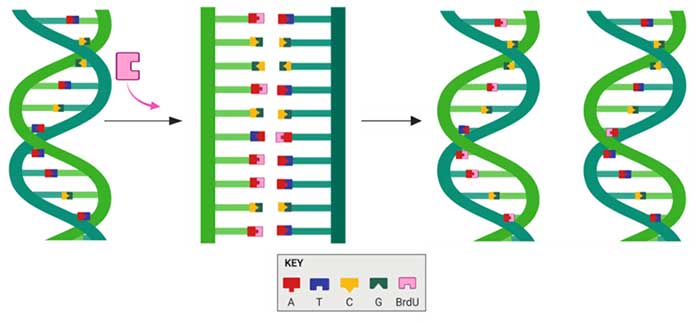PrecisionAb Anti-BrdU Antibodies

- On This Page
- What is cell proliferation and how to analyze it?
- Right antibody
- BrdU detection
- Validated Anti-BrdU antibodies
- Recombinant antibodies
What Is Cell Proliferation and How to Analyze it
Cell proliferation is the rapid expansion of a cell population due to cell growth and division. This cellular process must be carefully regulated as the smallest alterations can result in an uncontrolled increase of cell numbers, and eventually cancer. Cell proliferation can be measured by quantifying protein levels of key proliferation markers such as Ki-67, proliferating cell nuclear antigen (PCNA) and minichromosome maintenance 2 (MCM2), and also by measuring incorporation of bromodeoxyuridine (BrdU).
Finding the Right Antibody for BrdU Detection
Successful BrdU staining is challenging and time consuming with multiple steps requiring optimization. Finding the most suitable anti-BrdU antibody is one of the most important requirements of the experiment and can be very difficult to get right. At Bio-Rad, we have introduced a range of PrecisionAb Anti-BrdU Antibodies, to ensure robust, consistent, and reproducible results.
BrdU Detection
When added to dividing cells, the thymidine analog 5-bromodeoxyuridine (BrdU) can be specifically incorporated into newly-synthesized DNA as 5-bromouracil (Figure 1). This incorporation happens during the S phase of the cell cycle, when cells are synthesizing new DNA. Subsequent detection of BrdU, using highly specific antibodies, enables researchers to identify dividing cells.
As BrdU is a thymidine analog, it is essential to test anti-BrdU antibodies for cross-reactivity with thymidine. Binding of a BrdU antibody to thymidine could create unwanted background signal and affect experimental results. However, many anti-BrdU antibodies also recognize the other halogenated thymidine analogs, 5′-chloro-2′-deoxyuridine (CldU) and 5′-iodo-2′-deoxyuridine (IdU) (Liboska et al. 2012, Kimoto et al. 2008), due to the structural similarities. Knowing the cross-reactivity of your anti-BrdU antibody is critical, for example, when performing double-labeling experiments.

Fig. 1. BrdU can be specifically incorporated into newly-synthesized DNA as 5-bromouracil.
Extensively Validated Anti-BrdU Antibodies
Not all antibodies will be suitable for your specific BrdU labeling experiments so carefully choosing an antibody can save you time and ensure generation of accurate data. To support your proliferation studies, Bio-Rad’s expanded range of anti-BrdU antibodies, PrecisionAb Anti-BrdU Antibodies, have been extensively validated to show excellent performance in relevant biological samples with appropriate controls. They have been tested for suitability in specific applications including flow cytometry, fluorescent immunocytochemistry and immunohistochemistry. We provide detailed protocols for specific clones and applications. They have also been tested for cross-reactivity with thymidine and other thymidine analogs (Table 1) in order to meet your exact experimental requirements.
Table 1. Cross-reactivity results.
Cat# |
BrdU |
CIdU |
EdU |
IdU |
Thymidine |
|---|---|---|---|---|---|
|
HCA320 |
+ |
+ |
- |
+ |
- |
|
HCA321 |
+ |
+ |
- |
+ |
- |
|
HCA322 |
+ |
+ |
- |
+ |
- |
|
HCA323 |
+ |
+ |
- |
+ |
- |
|
MCA6143 |
+ |
+ |
+ |
+ |
- |
Greater Precision with Recombinant PrecisionAb Anti-BrdU Antibodies
Our range of anti-BrdU antibodies also includes recombinant anti-BrdU Antibodies, which offer the following added benefits:
- Experimental flexibility through choice of rat or rabbit isotypes
- Lot-to-lot consistency
- Long-term secure supply
- No immunization of animals, reducing the use of animals in research
These recombinant anti-BrdU antibodies were generated using the Human Combinatorial Antibody Libraries (HuCAL®), which is one of the most powerful synthetic antibody libraries. You can discover more about this technology on our HuCAL page.
Our PrecisionAb Anti-BrdU Antibody Range
| Description | Target | Format | Clone | Applications | Citations | Code |
|---|
As well as offering a full range of BrdU Antibodies, we also have a BrdU resource page, which offers a great selection of useful anti-BrdU protocols, tips and tricks, articles, and podcasts to help you with your BrdU labeling experiments.
References:
- Kimoto M et al. (2008). Label-retaining cells in the rat submandibular gland. J Histochem Cytochem 56, 15-24.
- Liboska R et al. (2012). Most anti-BrdU antibodies react with 2′-deoxy-5′-ethynyluridine – the method for the effective suppression of this cross-reactivity. PLoS One 7, e51679.



